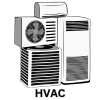The camshaft is a critical component in an internal combustion engine, responsible for operating the engine’s intake and exhaust valves. The camshaft uses lobes (cams) to push against the valves or the lifters that operate the valves, controlling their opening and closing.
There are several types of camshafts, classified based on design, location, operation, and actuation.
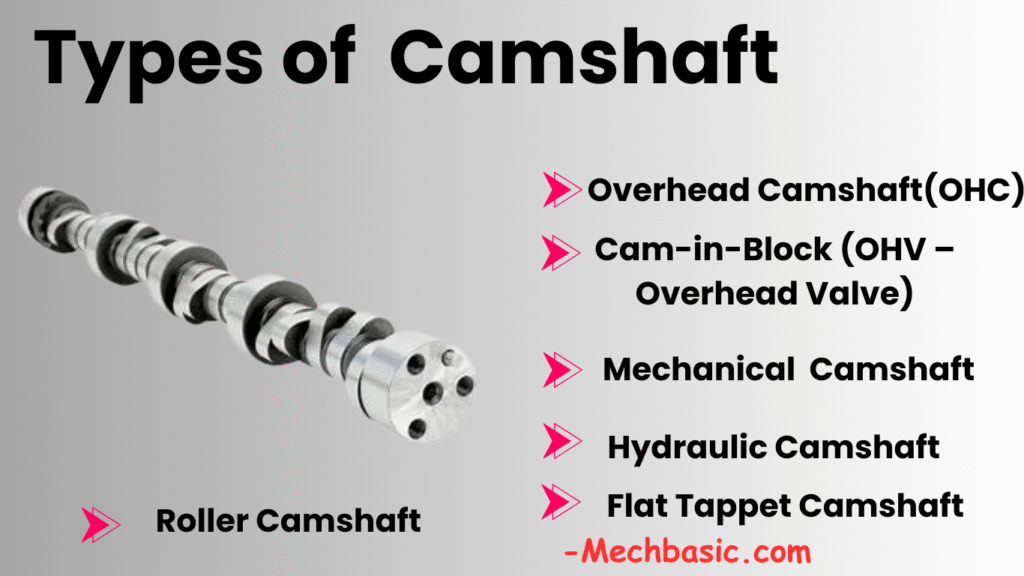
Types of Engine camshaft:
1. Based on Camshaft Location:
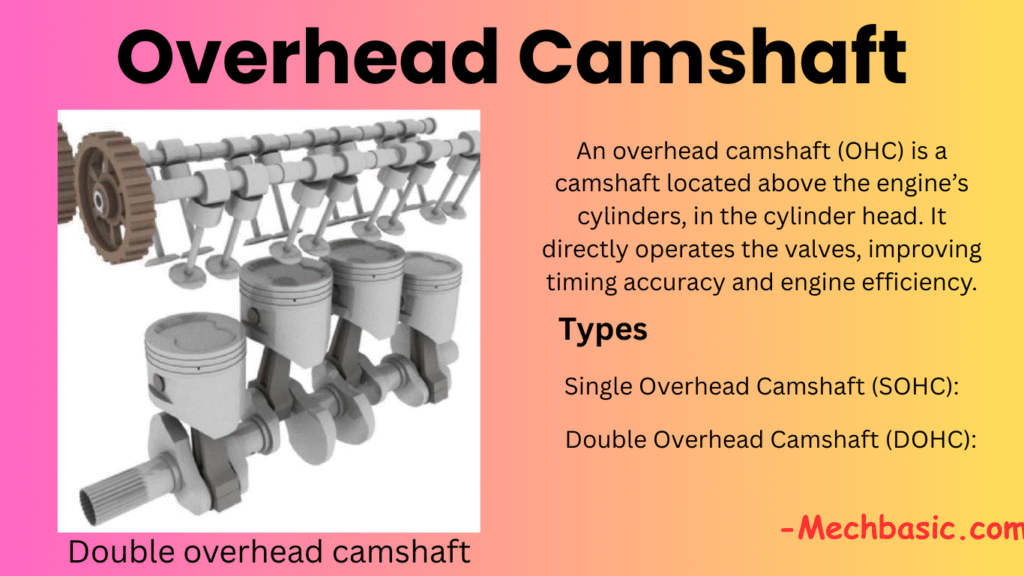
a) Overhead Camshaft (OHC):
An overhead camshaft (OHC) is a camshaft located above the engine’s cylinders, in the cylinder head. It directly operates the valves, improving timing accuracy and engine efficiency.
Also Read: Overhead camshaft in detail.
- Single Overhead Camshaft (SOHC):
- One camshaft located in the cylinder head.
- Operates both intake and exhaust valves.
- Common in inline engines.
- Advantages: Simpler than DOHC, more compact.
- Double Overhead Camshaft (DOHC):
- Two camshafts per cylinder head (one for intake, one for exhaust).
- Common in performance and multi-valve engines.
- Advantages: Better valve timing control, higher RPM potential, improved airflow.
Also Read : Difference between SOHC Vs DOHC.
b) Cam-in-Block (OHV – Overhead Valve):
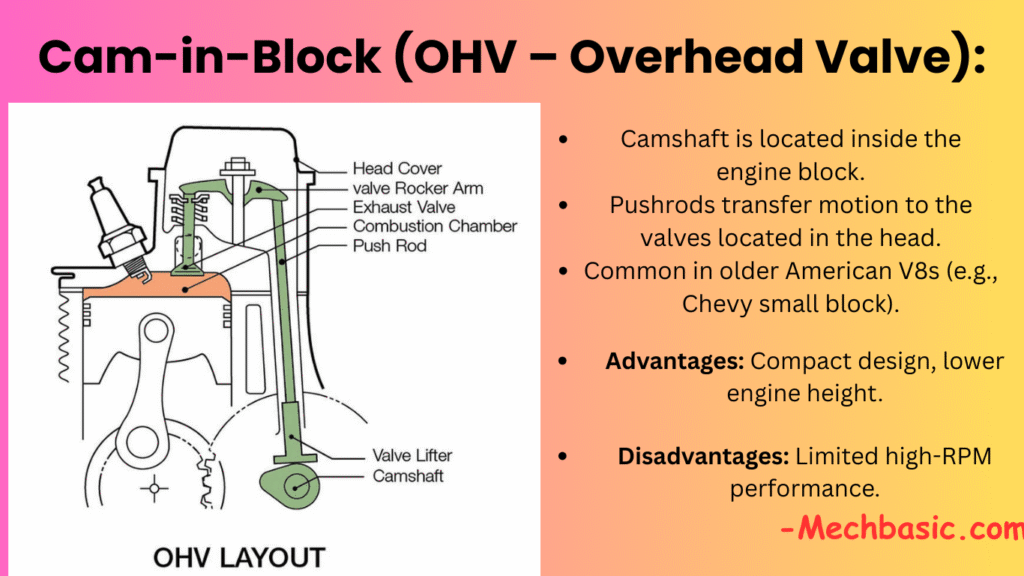
- Camshaft is located inside the engine block.
- Pushrods transfer motion to the valves located in the head.
- Common in older American V8s (e.g., Chevy small block).
- Advantages: Compact design, lower engine height.
- Disadvantages: Limited high-RPM performance.
⚙️ 2. Based on Camshaft Actuation
a) Mechanical (Solid) Camshaft:
- Uses solid lifters.
- No hydraulic compensation for valve lash.
- Requires periodic adjustment.
- Used in: High-performance or racing engines.
b) Hydraulic Camshaft
- Uses hydraulic lifters.
- Automatically maintains valve lash.
- Quieter operation, lower maintenance.
- Used in: Most modern passenger vehicles.
🔁 3. Based on Camshaft Profile/Functionality:
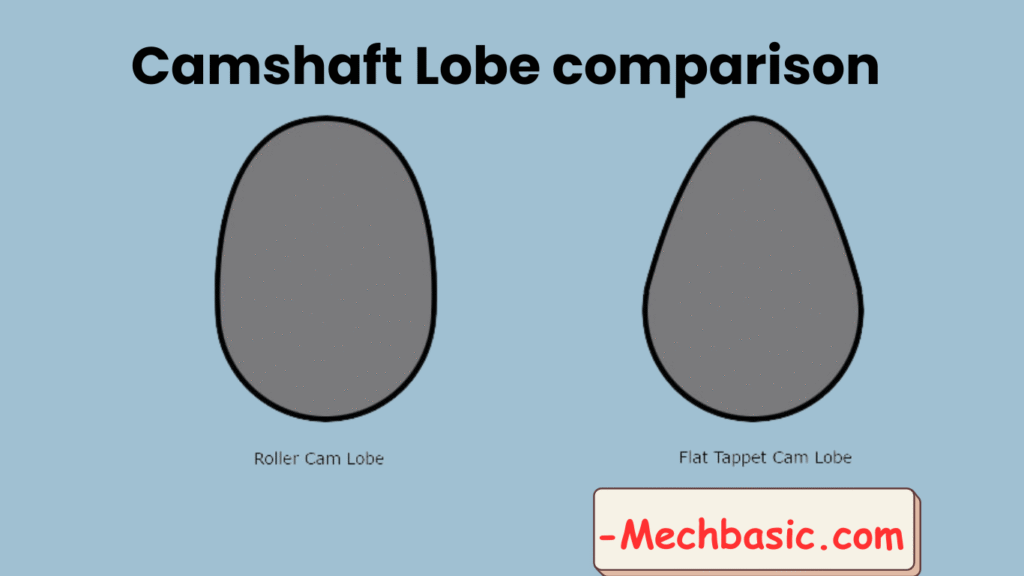
a) Flat Tappet Camshaft
- Uses flat lifters (tappets) that slide over the cam lobe.
- More common in older engines.
- Needs break-in period and specific oil additives.
b) Roller Camshaft
- Uses roller lifters which reduce friction.
- Allows for more aggressive cam profiles.
- Types:
- Hydraulic Roller
- Mechanical (Solid) Roller
Also Read: Flat tappet vs Roller camshaft.
4. Variable Camshaft Technology:
Used to optimize valve timing for power, efficiency, and emissions.
a) Variable Valve Timing (VVT) Camshaft
- Adjusts camshaft position during operation.
- Common systems: VVT-i (Toyota), VTEC (Honda), VANOS (BMW), VCT (Ford).
- Often uses hydraulics or electric actuators.
b) Cam Phasing vs. Cam Changing
- Cam Phasing: Adjusts the timing of the entire camshaft.
- Cam Changing: Switches between multiple cam profiles (e.g., Honda’s VTEC).
5. Custom/Aftermarket Camshafts
- Designed for specific performance goals: torque, top-end power, fuel economy, etc.
- Aftermarket cams often have higher lift and longer duration.
- Require tuning and sometimes upgraded valvetrain components.
Camshaft Design Parameters
Key features that define performance:
- Lift: How far the valve opens.
- Duration: How long the valve stays open.
- Lobe Separation Angle (LSA): Angle between intake and exhaust lobes.
- Timing: When valves open and close relative to piston position.
FAQ Section:
What are the main types of camshafts based on location?
The two main types are Overhead Camshaft (OHC) and Cam-in-Block (OHV).
What is the difference between SOHC and DOHC?
- SOHC (Single Overhead Camshaft): One camshaft operates both intake and exhaust valves.
- DOHC (Double Overhead Camshaft): Two camshafts per head, allowing better performance and valve control.
What is an OHV engine?
An OHV (Overhead Valve) engine has the camshaft located inside the engine block and uses pushrods to operate the valves.
What are flat tappet camshafts?
These use flat-bottomed lifters that slide over the cam lobes, common in older engines and budget builds.
What are roller camshafts?
Roller camshafts use lifters with small rollers that reduce friction and allow for more aggressive cam profiles.
Which is better: roller or flat tappet camshaft?
Roller cams offer better performance, durability, and efficiency but cost more. Flat tappet cams are simpler and cheaper.
What is variable valve timing (VVT) camshaft?
A VVT camshaft adjusts valve timing dynamically to optimize power, efficiency, and emissions.
What’s the role of a camshaft in engine performance?
The camshaft controls valve timing, which directly affects airflow, combustion, power output, and efficiency.
What does “camshaft profile” mean?
It refers to the cam lobe shape, which defines valve lift, duration, and timing — key factors in engine behavior.
How do I know which camshaft is in my engine?
Refer to the engine specs or service manual. You can often tell by the engine layout (OHC vs OHV) or valve cover shape.
Can I upgrade from flat tappet to roller camshaft?
Yes, but it usually requires lifter and sometimes valve train upgrades. It’s more common in performance builds.
Do all modern engines use overhead camshafts?
Most modern engines use OHC (SOHC or DOHC), but some V8s still use OHV for compactness and torque characteristics.
Why do racing engines prefer DOHC?
DOHC allows for better airflow, higher RPM operation, and precise valve timing—ideal for performance.
Do camshafts require maintenance?
While camshafts themselves are durable, associated components like lifters and timing systems may need maintenance or inspection, especially in flat tappet setups.
Other courses:
